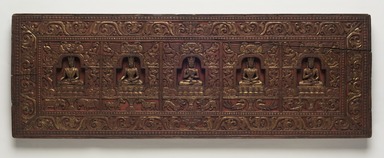
Medium: Wood, color, gold
Geograhical Locations:
Dates:ca. 1200
Dimensions: 9 5/8 x 27 1/2 x 1 1/8 in. (24.4 x 69.9 x 2.9 cm)
Collections:
Accession Number: 1997.59.1
Image: 1997.59.1_front_PS11.jpg,
Catalogue Description: Book cover elaborately carved in relief with red and gold polychromy on the inner surface, depicts the five tathagatas each in a chapel (caitya). Each tathagata is seated on a double lotus pedestal in a meditation pose with legs locked and soles of the feet turned upward. They are crowned and bejeweled with upper torso bare. The thrones of the tathagatas are supported by their vehicles and surmounted by horned Garudas clutching snakes in their hands and mouths. The deities are flanked on either side by rampant leogryphs riding on the backs of elephants below open mouthed makaras. Each throne is virtually identical but for the facial expressions of the Garudas. A classical scroll border surrounds the central field; the scroll issues from the mouth of the kiritimukha on the lower border and from a lotus flower on the upper border and the sides; repeated beaded borders. Twelve small holes along the top edge. The tathagatas wear the high triangular three pointed crown. The five tathagatas, or Dhyani Buddhas, and their animal vehicles are identified, as follows, from left to right: 1.Akshobhya with hands in the gesture of bhumisparsa mudra and two elephants; 2.Ratnasambhava, with hands in the gesture of varada mudra with two horses; 3.Vairocana, with hands in the gesture of dharmacakra mudra with two lions; 4.Amitabha with hands in dhyana (meditation) mudra, with two peacocks; 5.Amoghasiddhi with hands in the gesture of abhaya mudra with garudas, shown here as two kinnaras (mythical bird-human composite figures). At the ends, there are carved floral and animal designs. Arrived with its own metal stand.